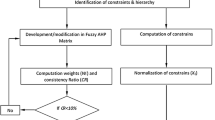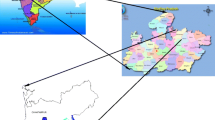Abstract
Watersheds from semiarid regions are more sensitive to hydrological processes and sustainability of water resources than humid regions. Hence, it is indispensable to determine the response of watersheds to hydrological processes for water resource management. Thus, the hydrological response-based watershed prioritization study has been undertaken for eight sub-watersheds from semiarid, basaltic region of Western Ghats of India. Intent to this, a novel index has been parameterized using thematic layers such as drainage density, geology, soil, slope, landform classification, land use/land cover, rainfall and runoff (DGSLR). This study evaluates the performance of DGSLR index using three models, namely analytical hierarchy process (AHP), frequency ratio (FR) and fuzzy logic for sub-watershed-wise prioritization. The FR ratio showed the highest value for very high drainage density (8.73) indicating most probability for a high hydrological response. According to AHP weight, most influencing factors to hydrological processes are precipitation (25%), slope (19%) and land use/land cover (14%) followed by landform classification (11%). These three methods are prioritized study area into four classes, i.e., very high, high, moderate and low using area-weighted average method. These models showed that very high-priority area lies near the outlet of the watershed as well as the upper part of the watershed in high to very high priority in all three models. It covers 33.12% of the total area having a high average slope with high drainage density in sub-watersheds 1, 3, 7 and 8. The predictive capability of DGSLR index was computed by the area under the curve (AUC) and receiver operating characteristic (ROC) method, revealed average accuracy for FR method (AUC = 89%) better than AHP method (AUC = 77%) and fuzzy logic (AUC = 76%). This novel index could be used by the water resources researchers and planners in any terrain to understand the hydrological response.






Similar content being viewed by others
References
Adiat, K. A. N., Nawawi, M. N. M., & Abdullah, K. (2012). Assessing the accuracy of GIS-based elementary multi criteria decision analysis as a spatial prediction tool—A case of predicting potential zones of sustainable groundwater resources. Journal of Hydrology, 440–441, 75–89. https://doi.org/10.1016/j.jhydrol.2012.03.028.
Agarwal, R., & Garg, P. K. (2015). Remote sensing and GIS based groundwater potential & recharge zones mapping using multi-criteria decision making technique. Water Resources Management. https://doi.org/10.1007/s11269-015-1159-8.
Aher, P. D., Adinarayana, J., & Gorantiwar, S. D. (2014). Quantification of morphometric characterization and prioritization for management planning in semi-arid tropics of India: A remote sensing and GIS approach. Journal of Hydrology, 511, 850–860. https://doi.org/10.1016/j.jhydrol.2014.02.028.
Alazba, S. H. M. A. A. (2016). Integrated remote sensing and GIS-based approach for deciphering groundwater potential zones in the central region of Saudi Arabia. Environmental Earth Sciences, 75(4), 1–28. https://doi.org/10.1007/s12665-015-5156-2.
Alvarado, A., Esteller, M. V., Quentin, E., & Expósito, J. L. (2016). Multi-criteria decision analysis and GIS approach for prioritization of drinking water utilities protection based on their vulnerability to contamination. Water Resources Management, 30(4), 1549–1566. https://doi.org/10.1007/s11269-016-1239-4.
Amin, M. G. M., Veith, T. L., Collick, A. S., Karsten, H. D., & Buda, A. R. (2017). Simulating hydrological and nonpoint source pollution processes in a karst watershed: A variable source area hydrology model evaluation. Agricultural Water Management, 180, 212–223. https://doi.org/10.1016/j.agwat.2016.07.011.
Anderson J. R., Hardy E. E., & Roach J. T. (1972). A land-use classification system for use with remote-sensor data. US Geological Survey Circle 671, 16
Aouragh, M. H., Essahlaoui, A., Ouali, A. El, & Hmaidi, A. El. (2016). Groundwater potential of Middle Atlas plateaus, Morocco, using fuzzy logic approach, GIS and remote sensing. Geomatics, Natural Hazards and Risk. https://doi.org/10.1080/19475705.2016.1181676.
Basahi, J., Masoud, M., & Zaidi, S. (2016). Integration between morphometric parameters, hydrologic model, and geo-informatics techniques for estimating WADI runoff (case study WADI HALYAH—Saudi Arabia). Arabian Journal of Geosciences, 9(13), 1–18. https://doi.org/10.1007/s12517-016-2649-6.
Bates, P. D. (2004). Remote sensing and flood inundation modelling. Hydrological Processes, 18(13), 2593–2597.
Gashaw, T., Tulu, T., & Argaw, M. (2017). Erosion risk assessment for prioritization of conservation measures in Geleda watershed, Blue Nile basin, Ethiopia. Environmental Systems Research. https://doi.org/10.1186/s40068-016-0078-x.
Gashaw, T., Tulu, T., Argaw, M., & Worqlul, A. W. (2018). Modeling the hydrological impacts of land use/land cover changes in the Andassa watershed, Blue Nile Basin, Ethiopia. Science of the Total Environment, 619–620, 1394–1408. https://doi.org/10.1016/j.scitotenv.2017.11.191.
Horton, R. E. (1945). Erosional development of streams and their drainage basins; hydrophysical approach to quantitative morphology. Geological Society of America Bulletin, 56(3), 275–370.
Jaiswal, R. K., Ghosh, N. C., Galkate, R. V., & Thomas, T. (2015). Multi criteria decision analysis (MCDA) for watershed prioritization. Aquatic Procedia, 4, 1553–1560. https://doi.org/10.1016/j.aqpro.2015.02.201.
Jiang, Y., Liu, C., Li, X., Liu, L., & Wang, H. (2015). Rainfall-runoff modeling, parameter estimation and sensitivity analysis in a semiarid catchment. Environmental Modelling and Software, 67, 72–88. https://doi.org/10.1016/j.envsoft.2015.01.008.
Jódar, J., Carpintero, E., Martos-Rosillo, S., Ruiz-Constán, A., Marín-Lechado, C., Cabrera-Arrabal, J. A., et al. (2018). Combination of lumped hydrological and remote-sensing models to evaluate water resources in a semi-arid high altitude ungauged watershed of Sierra Nevada (Southern Spain). Science of the Total Environment, 625, 285–300. https://doi.org/10.1016/j.scitotenv.2017.12.300.
Kadam, A. K., Jaweed, T. H., Umrikar, B. N., Hussain, K., & Sankhua, R. N. (2017). Morphometric prioritization of semi-arid watershed for plant growth potential using GIS technique. Modeling Earth Systems and Environment. https://doi.org/10.1007/s40808-017-0386-9.
Kadam, A. K., Kale, S. S., Pande, N. N., Pawar, N. J., & Sankhua, R. N. (2012). Identifying potential rainwater harvesting sites of a semi-arid, basaltic region of Western India. Using SCS-CN method. Water Resources Management, 26(9), 2537–2554. https://doi.org/10.1007/s11269-012-0031-3.
Kaliraj, S., Chandrasekar, N., & Magesh, N. S. (2013). Identification of potential groundwater recharge zones in Vaigai upper basin, Tamil Nadu, using GIS-based analytical hierarchical process (AHP) technique. Arabian Journal of Geosciences, 7(4), 1385–1401. https://doi.org/10.1007/s12517-013-0849-x.
Khadse, G. K., Vijay, R., & Labhasetwar, P. K. (2015). Prioritization of catchments based on soil erosion using remote sensing and GIS. Environmental Monitoring and Assessment, 187(6), 333. https://doi.org/10.1007/s10661-015-4545-z.
Kinthada, N. R., Gurram, M. K., & Eedara, A. (2013). Remote sensing and GIS in the geomorphometric analysis of micro- watersheds for hydrological Scenario assessment and characterization: A study on Sarada river basin, Visakhapatnam district, India. International Journal of Geomatics and Geosciences, 4(1), 195–212.
Langemeyer, J., Gómez-Baggethun, E., Haase, D., Scheuer, S., & Elmqvist, T. (2016). Environmental science & policy bridging the gap between ecosystem service assessments and land-use planning through multi-criteria decision analysis (MCDA). Environmental Science & Policy. https://doi.org/10.1016/j.envsci.2016.02.013.
Lee, S., Yeo, I.-Y., Sadeghi, A. M., McCarty, G. W., Hively, W. D., Lang, M. W., et al. (2017). Comparative analyses of hydrological responses of two adjacent watersheds to climate variability and change scenarios using SWAT model. Hydrology and Earth System Sciences Discussions. https://doi.org/10.5194/hess-2017-178.
Mogaji, K. A. (2017). Development of AHPDST vulnerability indexing model for groundwater vulnerability assessment using hydrogeophysical derived parameters and GIS application. Pure and Applied Geophysics, 174(4), 1787–1813. https://doi.org/10.1007/s00024-017-1499-9.
Molina-Navarro, E., Hallack-Alegría, M., Martínez-Pérez, S., Ramírez-Hernández, J., Mungaray-Moctezuma, A., & Sastre-Merlín, A. (2015). Hydrological modeling and climate change impacts in an agricultural semiarid region. Case study: Guadalupe River basin, Mexico. Agricultural Water Management. https://doi.org/10.1016/j.agwat.2015.10.029.
Nag., S. K., & Ghosh, P. (2013). Delineation of groundwater potential zone in Chhatna Block, Bankura District, West Bengal, India using remote sensing and GIS techniques. Environmental Earth Sciences, 70(5), 2115–2127.
Napoli, M., Massetti, L., & Orlandini, S. (2017). Hydrological response to land use and climate changes in a rural hilly basin in Italy. CATENA, 157, 1–11. https://doi.org/10.1016/j.catena.2017.05.002.
Nasiri, H., Boloorani, A. D., Sabokbar, H. A. F., Jafari, H. R., Hamzeh, M., & Rafii, Y. (2013). Determining the most suitable areas for artificial groundwater recharge via an integrated PROMETHEE II-AHP method in GIS environment (case study: Garabaygan Basin, Iran). Environmental Monitoring and Assessment, 185(1), 707–718. https://doi.org/10.1007/s10661-012-2586-0.
Nigussie, T. A., & Altunkaynak, A. (2016). Assessing the hydrological response of Ayamama watershed from urbanization predicted under various landuse policy scenarios. Water Resources Management, 30, 3427–3441. https://doi.org/10.1007/s11269-016-1360-4.
Nourani, V., Fard, A. F., Gupta, H. V., Goodrich, D. C., & Niazi, F. (2017). Hydrological model parameterization using NDVI values to account for the effects of land cover change on the rainfall–runoff response. Hydrology Research, 48(6), 1455–1473. https://doi.org/10.2166/nh.2017.249.
Oh, H., Kim, Y., Choi, J., Park, E., & Lee, S. (2011). GIS mapping of regional probabilistic groundwater potential in the area of Pohang City, Korea. Journal of Hydrology, 399, 158–172. https://doi.org/10.1016/j.jhydrol.2010.12.027.
Patel, D. P., Gajjar, C. A., & Srivastava, P. K. (2013). Prioritization of Malesari mini-watersheds through morphometric analysis: A remote sensing and GIS perspective. Environmental Earth Sciences, 69(8), 2643–2656. https://doi.org/10.1007/s12665-012-2086-0.
Paul, M., Rajib, M. A., & Ahiablame, L. (2017). Spatial and temporal evaluation of hydrological response to climate and land use change in three South Dakota watersheds. JAWRA Journal of the American Water Resources Association, 53(1), 69–88. https://doi.org/10.1111/1752-1688.12483.
Rabu, P. P., & Askaran, R. B. (2013). Drainage morphometry of upper Vaigai river sub-basin, Western Ghats, South India using remote sensing and GIS. Journal of the Geological Society of India, 82, 519–528.
Saaty, T. L. (1990). How to make a decision: The analytic hierarchy process. European Journal of Operational Research, 48(1), 9–26.
Saaty, T. L. (2008). Decision making with the analytic hierarchy process. International Journal of Services Sciences, 1(1), 83–98.
Sajinkumar, K. S., & Anbazhagan, S. (2015). Geomorphic appraisal of landslides on the windward slope of Western Ghats, southern India. Natural Hazards, 75(1), 953–973. https://doi.org/10.1007/s11069-014-1358-2.
Samal, D. R., et al. (2015). GIS based drainage morphometry and its influence on hydrology in parts of Western Ghats region, Maharashtra, India. Geocarto International. https://doi.org/10.1080/10106049.2014.978903.
Sarma, S., & Saikia, T. (2012). Prioritization of sub-watersheds in Khanapara–Bornihat Area of Assam–Meghalaya (India) based on land use and slope analysis using remote sensing and GIS. Journal of the Indian Society of Remote Sensing, 40(3), 435–446. https://doi.org/10.1007/S12524-011-0163-6.
Singh, G., & Panda, R. K. (2017). Grid-cell based assessment of soil erosion potential for identification of critical erosion prone areas using USLE, GIS and remote sensing: A case study in the Kapgari watershed, India. International Soil and Water Conservation Research, 5(3), 202–211. https://doi.org/10.1016/j.iswcr.2017.05.006.
Strahler A. N. (1964). Quantitative geomorphology of drainage basin and channel network. Handbook of Applied Hydrology, 39–76.
Sujatha, E. R., Selvakumar, R., & Rajasimman, B. (2014). Watershed prioritization of Palar sub-watershed based on the morphometric and land use analysis. Journal of Mountain Science, 11(4), 906–916. https://doi.org/10.1007/s11629-012-2628-7.
Sunde, M. G., He, H. S., Hubbart, J. A., & Urban, M. A. (2017). Integrating downscaled CMIP5 data with a physically based hydrologic model to estimate potential climate change impacts on streamflow processes in a mixed-use watershed. Hydrological Processes, 31(9), 1790–1803. https://doi.org/10.1002/hyp.11150.
Umrikar, B. N. (2016). Morphometric analysis of Andhale watershed, Taluka Mulshi, District Pune, India. Applied Water Science, 7(5), 2231–2243. https://doi.org/10.1007/s13201-016-0390-7.
Vollmer, D., Pribadi, D. O., Remondi, F., Rustiadi, E., & Grêt-Regamey, A. (2016). Prioritizing ecosystem services in rapidly urbanizing river basins: A spatial multi-criteria analytic approach. Sustainable Cities and Society, 20, 237–252. https://doi.org/10.1016/j.scs.2015.10.004.
Wiekenkamp, I., Huisman, J. A., Bogena, H. R., Graf, A., Lin, H. S., Drüe, C., et al. (2016). Changes in measured spatiotemporal patterns of hydrological response after partial deforestation in a headwater catchment. Journal of Hydrology. https://doi.org/10.1016/j.jhydrol.2016.09.037.
Worku, T., Khare, D., & Tripathi, S. K. (2017). Modeling runoff–sediment response to land use/land cover changes using integrated GIS and SWAT model in the Beressa watershed. Environmental Earth Sciences, 76(16), 1–14. https://doi.org/10.1007/s12665-017-6883-3.
Zhang, Y., Cheng, G., Li, X., Jin, H., Yang, D., Flerchinger, G. N., et al. (2017). Influences of frozen ground and climate change on hydrological processes in an Alpine Watershed: A case study in the upstream area of the Hei’he River, Northwest China. Permafrost and Periglacial Processes, 28(2), 420–432. https://doi.org/10.1002/ppp.1928.
Acknowledgements
The authors are thankful to Head, Department of Environmental Sciences, and Head, Department of Geology, S.P. Pune University, for extending their help to use the department laboratory for computing facilities. Authors are thankful to editor and reviewers for evaluating and improving the quality of this manuscript.
Author information
Authors and Affiliations
Corresponding author
Rights and permissions
About this article
Cite this article
Kadam, A., Karnewar, A.S., Umrikar, B. et al. Hydrological response-based watershed prioritization in semiarid, basaltic region of western India using frequency ratio, fuzzy logic and AHP method. Environ Dev Sustain 21, 1809–1833 (2019). https://doi.org/10.1007/s10668-018-0104-4
Received:
Accepted:
Published:
Issue Date:
DOI: https://doi.org/10.1007/s10668-018-0104-4




